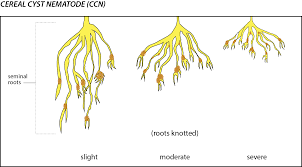
Exercise Assessing the Consequences of Microbial Infection in Field
Assessing the Consequences of Microbial Infection in Field Trials: Seen, Unseen, Beneficial, Parasitic and Pathogenic
Visual Disease Assessment
Assessment of visible disease symptoms remains the primary method for detecting and quantifying most crop diseases, both under controlled environments and in field trials. Visible disease assessments have been routinely used for many years in order to monitor varietal performance, for mapping major and quantitative resistances to crop pathogens or assessing the impact of various crop protection practices. Whilst visual assessment provides a relatively cheap and quick method for assessing entire field plots, such measurements are not necessarily true reflections of overall levels of infection. Furthermore, crops grown under field conditions can be exposed to a variety of plant pathogens, whilst the majority of major crop pathogens produce symptoms that are distinct and recognisable by appropriately trained field workers, less common pathosystems may produce similar or identical disease symptoms. Furthermore, in some cases, closely related pathogen species may not be distinguished by symptom expression despite differences in host pathogen interactions or agricultural significance. Abiotic stresses (often in conjunction with crop genotype) can produce phenotypes that are superficially similar to disease symptoms. As such, assessors require a high level of training and experience to be able to recognize and distinguish between common pathogens as well as physiological, disease-like, phenotypes.
Field Scoring Visible Disease Symptoms
For systemic diseases, or diseases that invariably kill whole plants, disease incidence may be a sufficient description, with disease on crops or plants being reported as either present or absent. Similarly, when disease levels are low, incidence may be an adequate approximation of severity. However, in most cases it is necessary to score disease severity as a quantitative trait. Most quantitative visual disease assessment protocols use disease severity keys with descriptions of symptoms that relate to varying levels of disease severity. Furthermore, heterogeneity in disease severity may exist within field plots, whilst the relationship between subjective assessment of disease and true levels of infection is not always simple. Inevitably, this leads to large subjective components in disease ratings. For a single assessor scoring a single trial this may have little significance, but when comparisons are made between trials, or multiple assessors are used for scoring single trials, these must be accounted for. A recent study examining the effect of subjectivity on the ability to detect QTL for northern leaf blight resistance in maize concluded that whilst variation between scorers was unlikely to affect the estimation of QTL locations, significant variation was detected in the estimation of QTL effects.
A number of attempts have been made to remove subjective components in disease assessment by automating symptom identification and quantification using image analysis techniques. Whilst such methods are now being employed in field settings, and can, in some cases, distinguish between symptoms caused by different pathogens, the applications of image analysis methods are generally too specific to be of use as a general tool. However, this area of research is developing rapidly, and improvements in computational techniques and imaging technologies has the potential to offer generalized tools for studying field infection.


